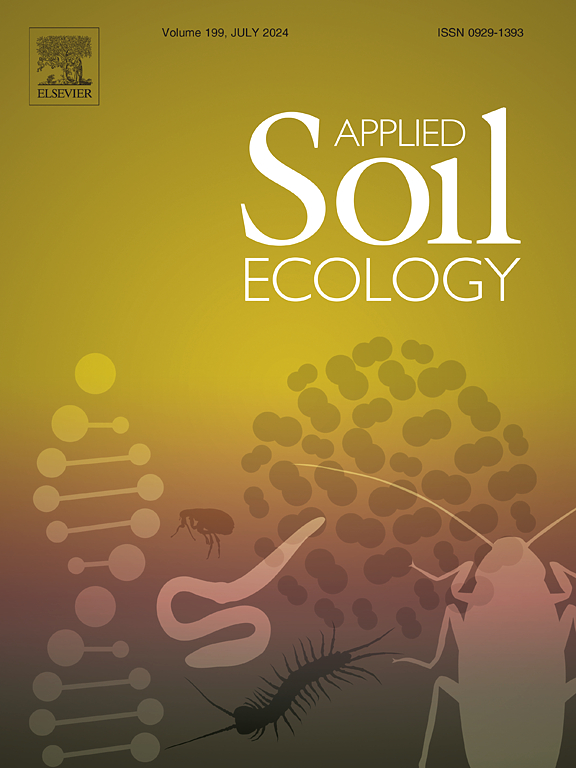Increased loss rate of straw-derived nitrogen following the woody peat addition is more significant in saline than in non-saline paddy soil
IF 5
2区 农林科学
Q1 SOIL SCIENCE
引用次数: 0
Abstract
Elucidating the biological mechanisms underlying the loss of straw-derived N is crucial for developing eco-friendly and cost-effective methods for straw return to the field; however, research on this topic is lacking, particularly an integrated comparison of the conditions for woody peat-amended and non-amended in saline and non-saline soils. In this study, a pot experiment was conducted to monitor N loss from maize (Zea mays L.) straw labeled with 15N in saline (S) and non-saline (S0) soils with woody peat addition (W) or a control without woody peat addition (W0). Woody peat input tended to significantly increase the loss rate of straw-derived N (LSN) by 2.21 % in S0 soil and 10.02 % in S soil. In addition to the total N (TN), narG and nirK genes, a group of highly relevant bacterial taxa, greatly contributed to the LSN variations, although the bacterial taxa composition under W0 conditions was significantly different from that under W conditions. Furthermore, the composition of the bacterial community was determined and the taxa enriched and depleted following straw application were isolated. Under W conditions, the LSN was positively regulated by the recruited bacterial taxa and negatively regulated by the depleted bacterial taxa. However, the opposite was observed under W0 conditions. These highly relevant bacterial taxa contained different proportions of denitrifiers, further implicating their important role in mediating the loss of straw-derived N. Our results provide new insights into the driving factors of woody peat input to LSN in saline and non-saline soils, with implications for developing reasonable usage measures to control straw-N loss.
添加木本泥炭后秸秆氮损失率的增加在含盐水稻土中比在不含盐水稻土中更为显著
阐明秸秆氮流失的生物学机制对于开发生态友好且经济有效的秸秆还田方法至关重要;然而,关于这一主题的研究还很缺乏,特别是对盐碱地和非盐碱地木本泥炭改性和未改性条件的综合比较。本研究采用盆栽试验方法,在添加木本泥炭(W)的盐渍(S)和不添加木本泥炭(W0)的非盐渍(S0)土壤和不添加木本泥炭的对照土壤中,监测15N玉米秸秆的氮素损失。木本泥炭的投入使秸秆源氮的损失率显著增加,分别在S型土壤和S型土壤分别增加2.21%和10.02%。尽管W0条件下细菌分类群组成与W条件下差异显著,但除了总氮(TN)外,narG和nirK这组高度相关的细菌分类群对LSN的变化也有很大贡献。此外,还测定了细菌群落的组成,并分离出秸秆施用后富集和减少的类群。在W条件下,LSN受招募细菌类群的正调控,受枯竭细菌类群的负调控。而在W0条件下则相反。这些高度相关的细菌类群含有不同比例的反硝化菌,进一步表明它们在介导秸秆氮流失中的重要作用。本研究结果为盐碱地和非盐碱地木质泥炭输入LSN的驱动因素提供了新的见解,为制定合理的利用措施控制秸秆氮流失提供了新的思路。
本文章由计算机程序翻译,如有差异,请以英文原文为准。
求助全文
约1分钟内获得全文
求助全文
来源期刊

Applied Soil Ecology
农林科学-土壤科学
CiteScore
9.70
自引率
4.20%
发文量
363
审稿时长
5.3 months
期刊介绍:
Applied Soil Ecology addresses the role of soil organisms and their interactions in relation to: sustainability and productivity, nutrient cycling and other soil processes, the maintenance of soil functions, the impact of human activities on soil ecosystems and bio(techno)logical control of soil-inhabiting pests, diseases and weeds.
 求助内容:
求助内容: 应助结果提醒方式:
应助结果提醒方式:


